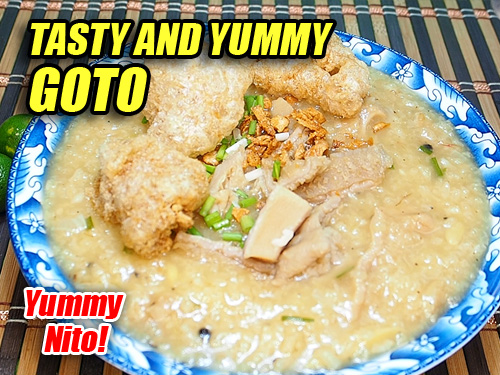Goto is a popular broth rice meal, specifically a Filipino gruel or rice porridge mixed with ox tripe. Sometimes it is referred to as arroz caldo con goto similar to (chicken) arroz caldo. There are other variation of goto but it simply a savory gruel mixed with ox tripe. My version here is garnishing it with chicharon, spring onions and fried garlic but you can also garnish it with boiled quail or chicken eggs.
Sunday Mornings and the Comfort of Goto
There’s something about goto that just brings me back to sleepy Sunday mornings in Tarlac, when the sky was still gray and quiet, and my Lola Merced would already be simmering something rich and fragrant in the kitchen. I remember waking up to the smell of toasted garlic and ginger dancing through the house, and I’d know—without even peeking—it was goto day.
It wasn’t just breakfast. It was comfort. It was tradition.
What is Goto and Why We Love It
Goto, also known in some areas as arroz caldo con goto, is a Filipino rice porridge made with ox tripe and glutinous rice. It’s often mistaken for its chicken counterpart, arroz caldo, but the main difference lies in the protein—it uses tender, gelatin-rich ox tripe that gives the dish a heartier, deeper flavor.
If you’re new to it, you might hesitate at the mention of ox tripe. But trust me—once it’s cleaned and boiled to perfect tenderness, it’s all about the texture and the way it soaks up the flavors of the broth. My cousin Tonio swears by pressure cooking the tripe first—he said it cuts the cook time in half and gets that “melt-in-your-mouth” consistency that makes or breaks a good goto.
My Family’s Take on Goto
This version of goto is one I’ve grown up with, passed from my Tita Nena who used to cook it for church fundraisers in Pangasinan. She always topped it with a generous handful of crushed chicharon, fried garlic, and spring onions, sometimes even a boiled quail egg if she had some in the fridge. “Always go big with toppings,” she’d say, “That’s what turns it from ordinary lugaw to something special.”
The base starts with glutinous rice soaked for a bit so it cooks evenly and gives you that thick, velvety consistency we love in any rice gruel. Then there’s the trifecta: ginger, garlic, and onion—gisa them in a bit of oil until the onions are soft and fragrant. Add patis, and here’s where you don’t stir right away. My kuya Jim taught me this trick—let the patis simmer for a minute first. That short wait brings out a deeper, umami flavor that’s more rounded and rich. Only then do you stir in the rice.
How to Get That Perfect Goto Consistency
Once the rice hits the pot, in goes the flavorful broth from the ox tripe. Simmer it slow and steady, stirring often to make sure it doesn’t stick to the bottom. Goto thickens as it cooks, so keep extra hot water on hand to loosen it if needed. The goal is a creamy, slightly soupy texture—not too dry, not too watery.
When the rice is soft and has turned into a lovely porridge, you add back the sliced tripe, season with magic sarap, black pepper, and toss in kasubha (safflower) for that signature golden hue. If you can’t find kasubha, a pinch of turmeric works, but kasubha has a subtle floral aroma that’s hard to beat.
Serving and Garnishing Goto
Here’s the fun part: toppings. For me, it isn’t complete without chicharon—the crunch against the soft porridge is just magic. Fried garlic and spring onions bring freshness and bite, while calamansi on the side gives a citrusy zing that cuts through the richness. My sister Liza likes adding a boiled egg or even shredded chicken when she’s feeling extra, and I say go for it. That’s the beauty of home cooking—you do you.
A Little History for the Curious
The word goto is believed to come from the Chinese term “ox tripe,” which isn’t surprising since many of our local dishes have Chinese influence. Through generations, Filipinos made it their own, adding local rice, fish sauce, and favorite garnishes. In the provinces, you’ll find little roadside stalls that serve goto with tokwa’t baboy and lugaw variations that change depending on who’s cooking. It’s not just food—it’s culture in a bowl.
Final Thoughts
If you’ve never cooked goto before, don’t worry. It may sound intimidating with the tripe and all, but it’s really just a pot of rice and broth made with love. Take your time with the prep, don’t rush the sauté, and keep stirring while it simmers. The reward is a warm, filling meal that hugs you from the inside out.
So the next time you’re craving something comforting, give this goto recipe a try. Maybe you’ll end up making it a Sunday morning tradition in your own home—just like we did.
How to Cook Goto
Ingredients
Goto ingredients:
- 1/2 kilo ox tripe twalya ng baka
- 2 pcs onion chopped
- 1/2 tsp. cracked black peppercorns
- 2 liters water
- 1/4 kilo glutinous rice malagkit rice
- 50 grams ginger sliced into strips
- 1 pc onion minced
- 1 Tbsp. spring onions
- 5 cloves garlic minced
- 1 Tbsp. patis
- 1 Tbsp. dried kasubha flowers dried safflower
- 1 tsp. salt
- 1/2 tsp. black pepper powder
- broth from boiled ox tripe
- cooking oil
Garnishing:
- fried garlic
- chopped spring onions
- pork chicharon
- sliced kalamansi for condiment
Instructions
How to Cook Goto
- Put the ox tripe, water, onion and black pepper in a pressure cooker. Boil the ox tripe in pressure cooker until tender.
- After cooking the ox tripe, slice it into strips. Set aside.
- Soak the glutinous rice in water for 15 minutes. Drain and set aside.
- Heat cooking oil in a wok or pot. Add ginger, garlic and onion. Sauté until the onion is soft.
- Add patis and let it simmer for 1 minute. Do not stir. Add the glutinous rice and stir for a few minutes.
- Add the ox tripe broth in the pot or wok. Cover and let it simmer until the rice becomes a gruel or lugaw.
- Stir to avoid burning the rice and sticking on the bottom of the pot. Add more water if necessary if the gruel becomes too thick.
- Add the boiled ox tripe, kasubha or safflower and spring onions. Add magic sarap and black pepper to taste. Continue stirring until the ingredients are well mixed.
- Serve hot and garnish with pork rinds or chicharon and spring onions. Serve with a slice of calamansi.
Video
Notes
Cooking Tips:
Pressure Cook the Ox Tripe for Tender Results
Ox tripe can be tough if not cooked long enough, so using a pressure cooker saves you hours and ensures a melt-in-your-mouth texture. Boil it with onion and pepper to build a flavorful base for your broth. Once tender, let it cool before slicing into strips for easier handling and better absorption of flavor later.Soak the Glutinous Rice Before Cooking
Soaking the rice for at least 15 minutes softens it and helps it cook faster and more evenly. This step also prevents clumping and gives your goto a smoother, silkier consistency. Don’t skip it if you want that classic creamy lugaw texture without constantly adding water.Simmer the Patis Before Stirring
When adding fish sauce during sautéing, let it simmer untouched for a minute before stirring in other ingredients. This brings out a deeper umami flavor and tames the sharp saltiness. It’s a simple step that makes your goto broth taste richer and more balanced.





Leave a Reply